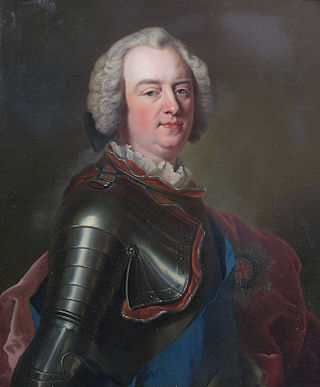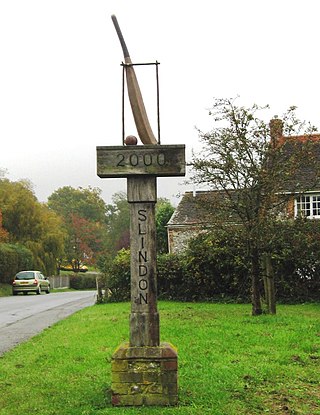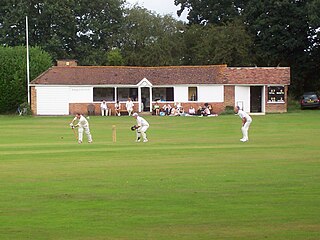Related Research Articles

The earliest definite reference to the sport of cricket is dated Monday, 17 January 1597. It is a deposition in the records of a legal case at Guildford, Surrey, regarding usage of a parcel of land. John Derrick, a coroner, testified that he had played cricket on the land when he was a boy in about 1550. Derrick's testimony is confirmation that the sport was being played by the middle of the 16th century, but its true origin is unknown. All that can be said with a fair degree of certainty is that its beginning was earlier than 1550, probably somewhere in south-east England within the counties of Kent, Sussex and Surrey. There have been suggestions that it can be traced to Flemish immigrants then resident in the area. The origin of the word cricket could derive from the Flemish word krick(-e), meaning a stick. Unlike other games with batsmen, bowlers and fielders, such as stoolball and rounders, cricket can only be played on relatively short grass, especially as the ball was delivered along the ground until the 1760s. Forest clearings and land where sheep had grazed would have been suitable places to play.
In the years from 1726 to 1750, cricket became an established sport in London and the south-eastern counties of England. In 1726, it was already a thriving sport in the south east and, though limited by the constraints of travel at the time, it was slowly gaining adherents in other parts of England, its growth accelerating with references being found in many counties. Having been essentially a rural pastime for well over a century, cricket became a focus for wealthy patrons and gamblers whose interests funded its growth throughout the 18th century.
The original London Cricket Club was formed in 1722 and was one of the foremost clubs in English cricket over the next four decades, holding important match status. It is closely associated with the Artillery Ground, where it played most of its home matches.

The 1744 cricket season in England is remembered for the earliest known codification of the Laws of Cricket. This was drafted by members of several cricket clubs, though the code was not published until 1755. Much of its terminology such as no ball, over, toss, umpire and wicket remain in current use. The season is also notable for the two earliest known surviving match scorecards. The second of those matches, played on Monday, 18 June, was a celebrated event in which a Kent county team challenged an England team at the Artillery Ground, Kent winning by one wicket.

Richard Newland was an English cricketer of the mid-Georgian period who played for Slindon and Sussex under the patronage of Charles Lennox, 2nd Duke of Richmond. He also represented various England teams and, in some matches, led his own select team. The eldest of three cricketing brothers, he is generally recognised as one of cricket's greatest early players and has been called a pioneer of the sport.
The 1741 English cricket season was the 45th cricket season since the earliest recorded eleven-a-side match was played. Details have survived of nine significant matches, including the first known appearance of Slindon Cricket Club. The earliest known tie in an eleven-a-side match occurred.
William Sawyer was an English cricketer who played during the 1730s and 1740s. He was mainly associated with Richmond and Surrey. Although information about his career is limited by a lack of surviving data, he is known to have made two single wicket and four other appearances between 1736 and 1747. He spent his whole life in Richmond and was an innkeeper there.
A variety of Kent county cricket teams played matches from the early 18th century until the formation of the original county club in 1842. The county's links to cricket go back further with Kent and Sussex generally accepted as the birthplace of the sport. It is widely believed that cricket was first played by children living on the Weald in Saxon or Norman times. The world's earliest known organised match was held in Kent c.1611 and the county has always been at the forefront of cricket's development through the growth of village cricket in the 17th century to representative matches in the 18th. A Kent team took part in the earliest known inter-county match, which was played on Dartford Brent in 1709.
The 1742 English cricket season was the 46th cricket season since the earliest recorded eleven-aside match was played. Details have survived of ten significant matches, including two famous matches London and Slindon in September.
The 1743 English cricket season was the 47th cricket season since the earliest recorded eleven-a-side match was played. Details have survived of 18 eleven-a-side and three single wicket matches.
The 1745 English cricket season was the second season following the earliest known codification of the Laws of Cricket.
The 1746 English cricket season was the third season following the earliest known codification of the Laws of Cricket.
The 1748 English cricket season was the fifth season following the earliest known codification of the Laws of Cricket. Details have survived of six significant eleven-a-side and 18 single wicket matches. 1748 was the halcyon season of single wicket, perhaps never so popular before or since.
The 1749 English cricket season was the sixth season following the earliest known codification of the Laws of Cricket.
The 1750 English cricket season was the seventh season following the earliest known codification of the Laws of Cricket. Details have survived of six eleven-a-side matches between significant teams, including three inter-county matches played between Kent and Surrey.

Edward Aburrow Sr., also known as Cuddy, was an English cricketer of the mid-Georgian period who played for Slindon and Sussex under the patronage of Charles Lennox, 2nd Duke of Richmond. He also represented various England teams. A resident of Slindon, Sussex, he was a contemporary of the three Newland brothers – Richard, John and Adam – who were his colleagues in the Slindon team. Outside of cricket, Aburrow Sr was a tailor in Slindon but he became involved in smuggling. He was jailed in 1745, though he turned King's evidence to gain parole. He relocated to Hambledon, Hampshire and his son Edward Aburrow Jr, also known as "Curry", became a regular Hambledon player.
Addington Cricket Club fielded one of the strongest cricket teams in England from about the 1743 season to the 1752 season although the village of Addington is a very small place in Surrey about three miles south-east of Croydon. The team was of county strength and featured the noted players Tom Faulkner, Joe Harris, John Harris, George Jackson and Durling. The team immediately accepted the Slindon Challenge, in 1744, to play against any parish in England. The only other club to accept was Robert Colchin's Bromley.

Hadlow Cricket Club was one of the early English cricket clubs, formed in the early to mid eighteenth century. Hadlow is a village in the Medway valley near Tonbridge in Kent.

Slindon Cricket Club was famous in the middle part of the 18th century when it claimed to have the best team in England. It was located at Slindon, a village in the Arun district of Sussex.
In English cricket, the years from 1751 to 1775 are notable for the rise of the Hambledon Club and the continuing spread of the sport across England. The Laws of Cricket underwent a re-codification in 1775, including the introduction of the leg before wicket rule and the addition of the third stump to the wicket.